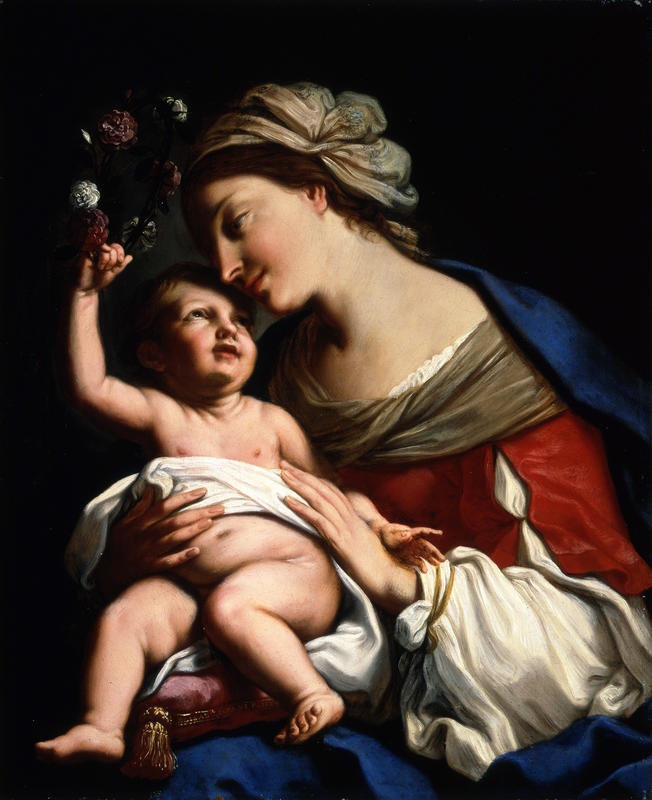More about Virgin and Child

Contributor
In Virgin and Child Sirani serves up a Madonna that’s just like us.
Sirani’s baby Jesus is considerably less elderly looking than the authoritative little men her predecessors painted. This piece (thankfully) contrasts with prior stick-up-the-bum depictions of the mother and son. Even Cima da Conegliano struggled with this iconic duo— see his unfinished Virgin and Child to view the two looking royally constipated. Clearly, baby Jesus posed quite the conundrum for painters back in the day. We can relate— it’s difficult to decide whether to portray an infant as an infant or as a shrunken old man gazing disapprovingly at his mother.
Sirani had no such difficulty. Perhaps her natural portraiture was the result of extensive training. After all, Elisabetta’s dear father encouraged her career to the end. With love, he took all her earnings and shut away her gifts. Nurturing to a fault, he encouraged her to work long hours in the studio. Doting as ever, he cut short Elisabetta’s dreams of travel. If Giovanni Sirani doesn’t scream “father of the year,” the bar is far too high. When Sirani passed away, Giovanni fought relentlessly to convict her killer. Unfortunately, Elisabetta’s fatal stomach ulcers were as likely induced by chronic stress as corrosive poison.
Virgin and Child fortunately holds no trace of Sirani’s gruesome future. After all, perforated ulcers have no place in a family portrait. Instead, Mary appears bright and relatable, with the turban Bolognese women wore in Sirani’s day. Her clothing is simple, unlike the luxurious drapings of nobility. This Mary screams “relatable,” and we’re not complaining.
Virgin and Child has continued to inspire, decorating more than a billion stamps in the '90s. Glowing reviews are to be expected— this is the artist who attracted nobility in droves to her studio, who taught numerous women to paint, and who was eventually buried near fellow Madonna fan Guido Reni. (That's the Virgin Mary kind, and not the Like A Virgin kind) So much success, so little TLC. Couldn’t the poor woman catch a break?
Sources
- “Artist Spotlight: Elisabetta Sirani.” National Museum of Women in the Arts. December 23, 2009. Accessed June 16, 2017. https://nmwa.org/blog/2009/12/23/artist-spotlight-elisabetta-sirani/.
- “Elisabetta Sirani.” Encyclopedia.com. 2004. Accessed June 16, 2017. http://www.encyclopedia.com/history/encyclopedias-almanacs-transcripts-….
- “Giovanni Andrea Sirani.” Wikipedia. October 14, 2016. Accessed June 15, 2017. https://en.wikipedia.org/wiki/Giovanni_Andrea_Sirani.
- Greer, Germaine. The Obstacle Race: The Fortunes of Women Painters and Their Work. New York: Tauris Parke Paperbacks, 2001. Accessed June 16, 2017. https://books.google.com/books?id=qnBu6eUvx18C&lpg=PA221&dq=elisabetta%…
- Ragg, Laura M. The Women Artists of Bologna. London: Methuen & Co., 1907. Accessed June 16, 2017. https://books.google.com/books?id=0Zg3AQAAMAAJ&dq=elisabetta%20sirani&p….
- “Virgin and Child.” National Museum of Women in the Arts. Accessed June 16, 2017. https://nmwa.org/works/virgin-and-child.
Featured Content
Here is what Wikipedia says about Virgin and Child (Sirani)
The Virgin and Child is an oil painting created by the Italian artist Elisabetta Sirani in 1663; she died two years later at the age of 27. The painting is owned by the National Museum of Women in the Arts in Washington, D.C. Its dimensions are 86 by 70 cm (34 by 28 in).
Check out the full Wikipedia article about Virgin and Child (Sirani)












